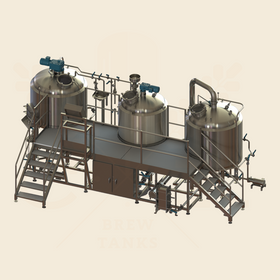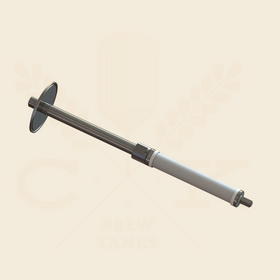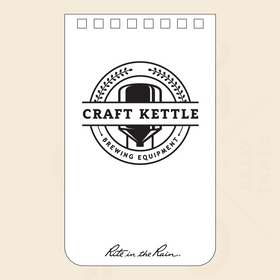
Milling
Introduction
Welcome, fellow brewing enthusiasts! Whether you're a seasoned pro or a craft beer lover looking to deepen your knowledge, you're in for a treat. This post marks the first in a series that will take you on a journey through the intricate and fascinating world of the steps of the brewing process.
Ask multiple brewers how many steps there are for wort production, and you'll soon find that opinions vary as widely as the flavors in a craft beer sampler. Is the vorlauf a part of the mash? Is the whirlpool the end of the boil? Regardless of what one considers a step, or a step within a step, it is important that all production brewers understand the typical process flow for commercial brewing.
Some may argue that grain handling is the real starting point (and they have their reasons), but we'll kick things off with milling. Barley specifications, malting, and grain conveying are important too, but those topics deserve their own spotlight in future posts.
So here we are, at the heart of it all, where a humble grain begins its transformation into the brews we all love. Let's dive into the first step: milling the grain. It's more than just crushing kernels; it's setting the stage for everything that follows.
Milling Overview
At a glance, milling seems like a pretty straight forward concept. Crush the grain so it can be exposed to hot water. Seasoned brewers will tell you though, that milling grain properly makes all the difference in terms of efficiently producing high quality wort.
Start-up breweries have multiple considerations when it comes to choosing a mill. When money is tight, the mill often gets overlooked as a lower necessity, with some start-ups deciding to rig up a janky homebrew mill, or forgo the mill completely by purchasing pre-milled malt. Both of these options potentially have negative impacts. A properly functioning in-house mill is a thing of beauty though, and can potentially save brewers many headaches.
Dry and wet mills are common throughout the industry and both have their pros and cons. The most common type purchased by start-up breweries is a 2-roller dry mill for simplicity, consistency, and affordability reasons. Before touching on these mills, it is important to understand the safety risks involved with milling grain in-house.
The first is that by crushing malt, you are inevitably making a fine, starchy powder which is highly flammable. Try “mill explosion” in an internet search if you need proof of just how dangerous flour can be. Mills are often kept in separate room because of this, with signs banning matches, lighters, and cell phones (because of their static electricity). Along with being explosive, this airborne powder may cause respiratory issues if the user is sensitive to dusts. Consider wearing a mask if any wheezing-like symptoms occur after use. Finally, the motor and rollers themselves use high energy inputs and are not capable of differentiating between grain and body parts. Do not attempt to adjust or work on the mill unless Lock Out, Tag Out measures have been performed to ensure that no power is being delivered to the motor.
Now back to the concept: 2-roller dry mills consist of 4 main parts; The hopper (inlet), the feed roller, a second roller, and the outlet. The hopper ensures constant feeding of malt to the rollers during a mill run. Hoppers are often large enough to fit the majority of a 50 pound malt bag. They may be equipped with magnets or screens at the bottom to prevent metals/stones/debris from making their way into the rollers, potentially causing explosions, damage to the rollers, or the risk of being carried further into the brewing process.
Rollers are made of iron, which provides the strength needed to crack thousands of tons of grain repeatedly. Additionally, both rollers are equipped with grooves or “fluting” patterns to increase the shearing forces on the malt as it passes through. They are positioned as a pair, with a gap in-between them (referred to as the mill gap). While in operation, the feed roller rotates at a slightly higher rpm than the second roller, this allows steady flow into the mill gap.

Photo: Example of a 2-roller home brew mill. The mill gap is being measured with a tool commonly used to determine spark plug gaps
The importance of the mill gap setting cannot be overstated. Having the right gap between rollers allows the brewer to maximize malt usage. This translates to an increase in brew house efficiency and often decreases lautering time (in other words, this potentially provides huge savings on money and time).
Grist and Grain Handling
The floury product collected after milling is referred to as grist, and a mill gap setting’s effectiveness can be measured using a grist analysis test. This test consists of a series of sieves which separate the grist into an organized grist profile including sections for husk, grits (larger chunks of starch), course flour, and fine flour. Every brewing system will function optimally under its own, specific grist profile. Equipment manufacturers will typically provide ideal mill gaps or grist profiles to their customers.

Photo: Grist Analysis sieves used for determining a grist profile

Photo: Example of a grist profile
Once the grist is created it is collected in the bottom of the mill. The grist typically moves through the outlet with assistance from a mechanical conveying system. The most common conveyors are a screw auger or a chain linked track. Both quickly and conveniently move the grist to the mash tun.
More Advanced Milling
As breweries grow in size new wort production systems are inevitably considered, including new mills. The milling process complexity increases with mills that utilize more than 2 rollers (4, 5, or 6 roller options) or by steeping malt before milling (referred to as wet milling). Although the systems may become more complex they have the same two end goals; to maximize the extract potential of the malt being used, and to provide a grist profile compatible for the brewing system in place.
Maintenance
Just like any other piece of equipment in the brewery, it is the brewer’s responsibility to ensure that the mill is receiving proper maintenance. Refer to manufacturer suggestions in regards to caring for the mill motor over time. Set a schedule for proper mill checks including; checking the distance between the mill gap and adjusting accordingly, performing grist analysis tests in-house or by sending grist to a 3rd party lab, and observing the fluting patters on rollers. The hardness of the malt will inevitably wear out these patterns, resulting in the need to eventually replace the rollers.
While caring for a dusty mill isn’t quite as glamorous as sampling beer from a shiny brite tank, it is another essential task in the brewery. Make sure to do so in a safe and thoughtful manner.
Happy brewing.
Photo References:
Mill gap photo:
https://www.homebrewfinds.com/2016/08/hands-on-cereal-killer-grain-mill.html
Grist analysis photo:
https://accidentalis.com/malt-crush-getting-nerdy-with-your-mill/
Grist profile: https://www.homebrewersassociation.org/attachments/presentations/pdf/2014/How%20Good%20Is%20Your%20Grist.pdf




